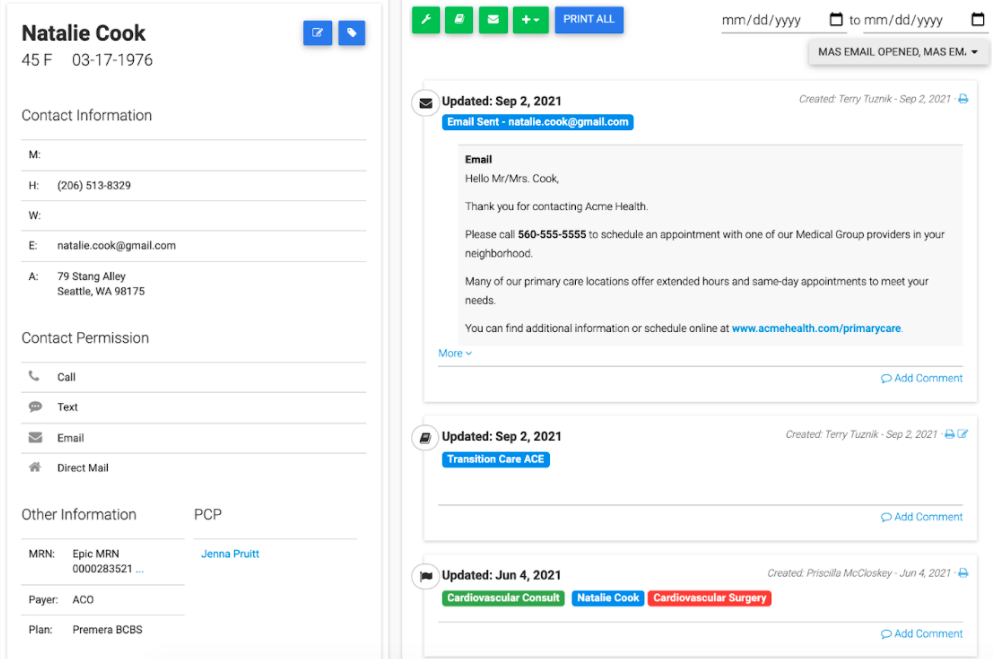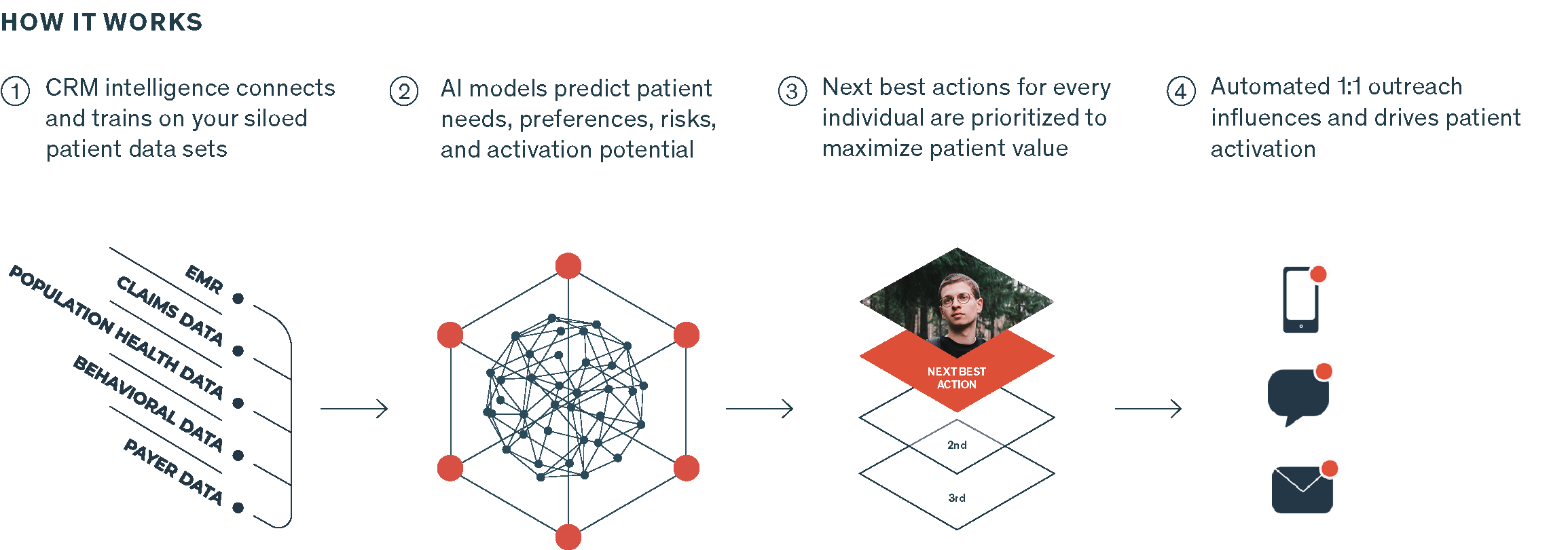Users of healthcare customer relationship management (CRM) software have high expectations of the technology, from managing a wide range of functions to solving core strategic challenges.
In real-world experiences, CRM solutions can unquestionably perform certain tasks very well. They store patient contact information, track non-clinical interactions, and, through integrations with other systems, display a variety of patient-centric data in one place.
Given appropriate expectations, a healthcare CRM can provide considerable value to both healthcare provider systems and payers. But it’s important to understand what CRM platforms don’t do (even if they are sometimes promoted that way).
What is Healthcare CRM Software?
Healthcare CRM (sometimes referred to as patient relationship management, or PRM) software is an industry-specific version of CRM systems, designed to meet the unique needs of hospitals, health systems, and clinics. Its purpose is to help healthcare providers attract new patients and improve communication with existing patients.[1]

According to HIMSS, the term “healthcare CRM” can also refer to “an organization-wide strategy for managing an organization’s interactions with its patients and their supporting infrastructure, suppliers, providers, and/or employees using CRM technologies. It seeks to optimize the way we establish and nurture meaningful and sustainable relationships in efforts to enhance patient experience, improve population health, reduce costs and improve the work life of healthcare providers – ultimately leading to increased trust in and loyalty to the organization.”[2]
A healthcare CRM database contains names, contact information, and records of interactions with current and prospective patients. It centralizes information about patients, provides a broad view of their marketing and business-related communications, and enables reporting and analytics. In that way, healthcare CRM systems are like any other CRM implementation.
What sets healthcare CRM software apart is partly vocabulary (patients rather than customers or clients) and partly functionality. Wikipedia[3] lists three key differences:
- Healthcare CRM and all automated communication must meet government security and privacy standards. With the United States this requires HIPAA and HITECH compliance.
- Healthcare CRMs incorporate Clinical Decision Support Systems to maintain patient safety.
- Healthcare CRM service automation automates healthcare specific services, such as provider scheduling, patient intake, and nurse triage making Healthcare service CRMs the most healthcare-unique form of CRM.
What is EHR?
An electronic health record (EHR) is a comprehensive digital medical file for a patient, designed to move with the patient across providers. Per HealthIT.gov[4], EHRs are “real-time, patient-centered records that make information available instantly and securely to authorized users. While an EHR does contain the medical and treatment histories of patients, an EHR system is built to go beyond standard clinical data collected in a provider’s office and can be inclusive of a broader view of a patient’s care.”
An EHR contains a range of data such as a patient’s medical history, diagnoses, medications, treatment plans, immunization dates, allergies, radiology images, and laboratory and test results, in addition to basic contact information.
Though the terms EHR and EMR (for electronic medical record) are often used interchangeably, there are several key differences.[5] An EMR is essentially a digital patient chart, primarily used for diagnosis and treatment within a facility, and not designed to share outside the practice. An EHR, by contrast, is a more comprehensive record of a patient’s health information, designed to be shared across providers and labs.
Healthcare CRM Software vs. EHR
While electronic health records (EHR) systems store patient clinical data and interactions, healthcare CRM software manages non-clinical data and information. So, an EHR platform, for example, will track medical records, prescriptions, patient health history, referrals, and diagnostic test results.
A CRM application will store records of patient communications, payment history, and marketing campaigns. CRM and EHR systems overlap on data like patient addresses, contact preferences, and notes about topics like family circumstances or patient interests.
EHR and CRM systems provide the most value when they are integrated, delivering a single, more comprehensive view of patient information. This integration is increasingly common though by no means universal. To be clear, however, CRM systems will never display clinical data because there will be staff members accessing the CRM platform who don’t have access rights to protected health information (PHI).
Healthcare CRM Software vs. Other Point Solutions

While some sources[6] suggest that functions like patient appointment scheduling and invoicing can be managed by CRM systems, and others tout[7] that they provide an even broader range of capabilities for managing staff scheduling, medications, physician referrals, recruiting, or even remote patient monitoring[8], those functions are actually nearly always handled by specific point solutions.
The benefit such best-of-breed applications provide is that they are highly effective at managing specific tasks such as appointment scheduling or medication management. The downside is that they also create data silos. The best healthcare CRM systems can integrate broadly with these applications to provide “single pane of glass” visibility into a wide range of patient data—but they don’t apply any intelligence to take specific actions based on that data.
The “Patient 360” Promise
Integrating healthcare CRM with EHR/EMR platforms and other point solutions can in theory deliver Patient 360, combining non-clinical data with other siloed data to provide a single, unified “full view of a patient’s longitudinal record including behavioral data, socioeconomic data and more[9]” per Chief Healthcare Executive.
But can it do this in reality? Can any healthcare professional look into their CRM and see all of the information pertaining to a specific patient regarding appointments, medications, remote monitoring, billing and invoicing, marketing campaigns, contact history, etc.? It’s a challenge to find any health system, of any size, that has achieved this.
And even if this were achievable, what then? What the physician, nurse, administrator, or marketing professional would see is a vast collection of facts about the patient, with no actionable context. Such a data set alone, as comprehensive as it may be, doesn’t tell the person viewing it what to do next based on all of that information.
What’s Really Needed: CRM Intelligence
Why is Amazon so good at showing you interesting products? And Facebook at showing you appealing ads? And Netflix at suggesting what to watch next?
These platforms use sophisticated data analysis to determine what you are most likely to find interesting and how to best encourage response. And they’ve gotten very good at it.
Yet these are trivial decisions. If they miss the mark, a small amount of someone’s time or money has been poorly spent. In healthcare, identifying the next best action for a specific patient to take—such as what kind of screening or diagnostic test they should schedule—can have a significant impact on a patient’s care journey.
Given the stakes are maximizing patient outcomes and fulfilling your organization’s brand promise, CRM intelligence is far more strategically important in healthcare than in ecommerce or entertainment. Yet healthcare CRM systems, for all the value they provide in terms of visibility and contact management, aren’t designed to supply predictive analytics.
CRM intelligence fills that gap. It trains artificial intelligence (AI) on your disparate patient data sets to identify that next best action from among all the possible recommendations that could be made to any specific patient, then automatically delivers that message through the medium the patient is most likely to respond to.
It avoids over-communication that confuses and annoys patients. It enables healthcare marketers to see the results of their campaigns, and demonstrate the value of their activities to drive revenue and improve patient outcomes.
In short, it extends the value of healthcare CRM to deliver what both health systems and their patients really need: the right message, automatically delivered the right way, at the right time to influence and activate them to perform a task – be it scheduling an appointment, completing a health risk assessment form, signing up for Medicare Advantage, etc. One example of leading health systems deploying CRM intelligence is launching patient activation programs to schedule annual wellness visits (AWVs). Health systems using AI-driven outreach see results with AWVs such as 2X growth in referral revenue. These visits are an important point of contact for closing care gaps and provide a gateway to other needed care.

Questions to Ask Your CRM Vendor
Healthcare CRM platforms are useful as tools to store and organize non-clinical patient data, and provide a historical record of patient communications and preferences. But too often, such systems contribute to rather than alleviating “data overload,” and they are backward-looking, not designed to provide predictive assistance that helps increase patient activation.
Here are five key questions to ask of your current CRM vendor:
- As part of our health system’s technology infrastructure, can you help integrate patient, payer, and population health data to provide actionable, individual patient insights?
- Can you help us target and personalize activation outreach based on individual patient needs?
- Can you help us predict patient needs before their conditions become urgent and costly?
- Can your software analyze results of past patient outreach to optimize future campaigns?
- Can your system help improve our agility to quickly adapt our outreach strategies to changing conditions and priorities?
If your current technology can’t meet those needs, it may be time to look at solutions that can optimize the use of your healthcare systems disparate data sets to provide predictive intelligence.
Getting Results That Matter
For leaders of today’s health systems, patient activation is the top priority. Delivering the right message to the right patient at the right time through the right channel provides multiple high-value benefits:
- It improves patient outcomes by helping physicians identify and treat conditions early, preventing more serious illness and higher costs.
- It builds relationships and encourages patients to seek care through their primary health system rather than turning to alternative providers, including retail competitors and digital health companies.
- It increases appointment volume and drives revenue growth to support the mission.
- It helps improve CMS quality scores based on providing timely, effective, patient-centered care.
- It helps to reduce the total cost of care, making value-based care more profitable.
CRM intelligence delivers these benefits by deriving actionable insights that lead to authentic patient experiences from your population health data across systems: EHR/EMR, CRM, claims, behavioral, and payer data. It cuts through data paralysis to automatically communicate the best next action based on individual patient needs, improving activation and eliminating confusing over-communication.
In short, it improves patient health and business outcomes. And it demonstrates the value of marketing in improving the patient experience, growing revenue, and helping reduce the total cost of care.
To learn more about how health systems are looking to maximize patient activation and lifetime value with AI-powered CRM intelligence tools, download the white paper: Moving Beyond Traditional Healthcare CRM.

Sources:
[1] Healthcare CRM, Software Advice
[2] Definition of CRM Technology in Healthcare, HIMMS.org
[3] Healthcare CRM, Wikipedia
[4] What is an Electronic Health Record (EHR)?, HealthIT.gov
[5] EHR (electronic health record) vs. EMR (electronic medical record), Practice Fusion
[6] CRM In Healthcare To Enhance Patient Satisfaction, EngageBay
[7] The Features and Benefits of Healthcare CRM Software, Onix Systems
[8] Healthcare CRM, Wikipedia
[9] Patient 360: Bringing Disparate Information into One View, Chief Healthcare Executive

